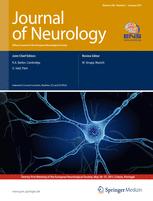 In this study, the features of nerve enlargement in inherited and acquired demyelinating neuropathies were compared using ultrasound. The authors measured median and ulnar nerve cross-sectional areas in proximal and distal regions in 128 children and adults with inherited [Charcot-Marie-Tooth-1 (CMT-1) (n = 35)] and acquired [chronic inflammatory demyelinating polyneuropathy (CIDP) (n = 55), Guillaine-Barre syndrome (GBS) (n = 21) and multifocal motor neuropathy (MMN) (n = 17)] demyelinating neuropathies. Nerve enlargement was classified by degree and number of regions affected. Patterns of nerve enlargement were defined as: none, no enlargement; mild, nerves enlarged but never more than twice normal; regional, nerves normal in at least one region and enlarged more than twice normal in at least one region; diffuse, nerves enlarged at all four regions with at least one region more than twice normal size. Nerve enlargement was commonly diffuse (89 %) and generally more than twice normal size in CMT-1, but not (p < 0.001) in acquired disorders, which mostly had either no, mild or regional nerve enlargement [CIDP (64 %), GBS (95 %), and MMN (100 %)]. In CIDP, subjects treated within 3 months of disease onset had less nerve enlargement than those treated later. Ultrasound identified patterns of diffuse nerve enlargement can be used to screen patients suspected of having CMT-1. Normal, mildly, or regionally enlarged nerves in demyelinating polyneuropathy suggests an acquired etiology. Early treatment in CIDP may impede nerve enlargement.
In this study, the features of nerve enlargement in inherited and acquired demyelinating neuropathies were compared using ultrasound. The authors measured median and ulnar nerve cross-sectional areas in proximal and distal regions in 128 children and adults with inherited [Charcot-Marie-Tooth-1 (CMT-1) (n = 35)] and acquired [chronic inflammatory demyelinating polyneuropathy (CIDP) (n = 55), Guillaine-Barre syndrome (GBS) (n = 21) and multifocal motor neuropathy (MMN) (n = 17)] demyelinating neuropathies. Nerve enlargement was classified by degree and number of regions affected. Patterns of nerve enlargement were defined as: none, no enlargement; mild, nerves enlarged but never more than twice normal; regional, nerves normal in at least one region and enlarged more than twice normal in at least one region; diffuse, nerves enlarged at all four regions with at least one region more than twice normal size. Nerve enlargement was commonly diffuse (89 %) and generally more than twice normal size in CMT-1, but not (p < 0.001) in acquired disorders, which mostly had either no, mild or regional nerve enlargement [CIDP (64 %), GBS (95 %), and MMN (100 %)]. In CIDP, subjects treated within 3 months of disease onset had less nerve enlargement than those treated later. Ultrasound identified patterns of diffuse nerve enlargement can be used to screen patients suspected of having CMT-1. Normal, mildly, or regionally enlarged nerves in demyelinating polyneuropathy suggests an acquired etiology. Early treatment in CIDP may impede nerve enlargement.
